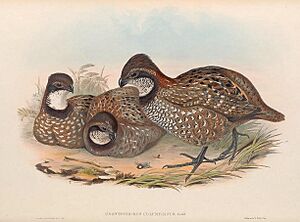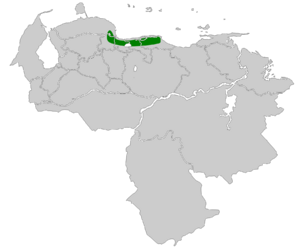Venezuelan wood quail facts for kids
Quick facts for kids Venezuelan wood quail |
|
|---|---|
 |
|
| Illustration by John Gould & H. C. Richter | |
| Conservation status | |
| Scientific classification | |
| Genus: |
Odontophorus (bird)
|
| Species: |
columbianus
|
 |
|
The Venezuelan wood quail (Odontophorus columbianus) is a type of bird that belongs to the New World quail family, Odontophoridae. You can find this bird living in the Venezuelan Coastal Range.
Contents
About the Venezuelan Wood Quail
What is Taxonomy?
Scientists who study animals sometimes group similar species together. This is called taxonomy. Some experts have thought that the Venezuelan wood quail might actually be the same species as a few other wood quails, like the gorgeted wood quail and the Tacarcuna wood quail. However, most bird scientists don't agree with this idea. So, for now, the Venezuelan wood quail is considered its own unique species.
How to Spot a Venezuelan Wood Quail
This bird is about 25 to 30 centimeters (10 to 12 inches) long. That's about the length of a ruler! Male quails weigh around 343 grams (12 ounces), and females are a little lighter at 336 grams (11.8 ounces).
Adult males have a white throat and chin with thin black lines. The rest of their body is a reddish-brown color, with big white spots on their chest, belly, and sides. Females have lighter brown undersides with less noticeable white spots. Young quails look similar to the females.
Where They Live
The Venezuelan wood quail mostly lives in the central part of Venezuela's Coastal Range. This area stretches from Carabobo to the northwest part of Miranda. There have also been a couple of times when they were seen in Táchira, which is in the west near the border with Colombia.
These birds like to live on the ground in special kinds of forests called subtropical cloudforests. They prefer places that are high up, between 800 and 2400 meters (2,600 to 7,900 feet) above sea level.
Behavior and Life
What They Eat
The Venezuelan wood quail finds its food by scratching through leaves and dirt on the forest floor. They enjoy eating seeds, fruits, insects, worms, and even roots.
Reproduction and Nests
The breeding season for the Venezuelan wood quail usually starts in March and might last until the end of July. Scientists have only found one nest so far! This nest was built at the bottom of some palm trees and had a roof made of plants. It contained six eggs.
Their Call
When these quails want to call out, they make a quick, back-and-forth sound with another quail. It sounds like "churdole-chur-it, churdole-chur-it..."
Their Status in the Wild
The IUCN (International Union for Conservation of Nature) has listed the Venezuelan wood quail as "Near Threatened." This means they are worried about the bird's future. The reason is that the area where they live is getting smaller because of habitat loss (their homes are being destroyed). Also, hunting is a problem for them.


